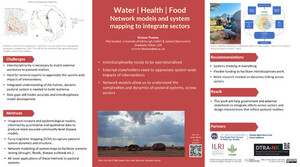
Water intake and nutrient balances of Holstein X Boran cows fed a low-quality tropical diet
Abstract
Study was conducted to determine turnover of water, nitrogen and energy in lactating Holstein x Boran cows. Nine cows (Bos indicus × B. taurus) between their 42nd and 420th the days of lactation were selected for this study. The crossbred cows had ad libitum access to water and a dried maize stover/lablab mixture (3:1), and received 3.2 kg of concentrate (wheat bran, molasses, bone meal) and 3 kg of fresh Napier grass per day. After an adaptation period of 7 days, feed intake and excretion of faeces, urine and milk were quantitatively recorded and samples proportionate to excretion were taken. for seven days period. Data on milk and body weight were collected twice daily or every second week, respectively, throughout lactation. Milk yield decreased by 12 (±0.192) g-day-1 during the lactation period. Milk fat, protein and energy concentrations were 4.9 (±0.467) %, 3.2 (±0.064) %, 3.2 (±0.180) MJ⋅kg-1, respectively. Dry matter digestibility was 57.6 (±7.84) % and the amount of faecal dry matter excreted was 4.1 (±0.821) kg ⋅day-1. Energy and nitrogen balance were slightly positive, which was confirmed by the small weight gain. Crossbred cows consumed daily 52.6 (±4.33) kg water, including the water in feed. Water excreted with faeces, urine and milk was 23.8 (±3.68), 10.3 (±1.89), 5.7 (±1.56) kg⋅day-1, respectively. Hence, the water balance of 15.8 (±2.29) kg day-1 was explained as water excreted by evapo-transpiration. Results indicate that with the quantity and quality of feed used in the study, variation in milk yield during the lactation does not affect the water consumption and total turn over of crossbred cows, although there is a shift from milk to faeces in water loss with advancing lactation.Study was conducted to determine turnover of water, nitrogen and energy in lactating Holstein x Boran cows. Nine cows (Bos indicus × B. taurus) between their 42nd and 420th the days of lactation were selected for this study. The crossbred cows had ad libitum access to water and a dried maize stover/lablab mixture (3:1), and received 3.2 kg of concentrate (wheat bran, molasses, bone meal) and 3 kg of fresh Napier grass per day. After an adaptation period of 7 days, feed intake and excretion of faeces, urine and milk were quantitatively recorded and samples proportionate to excretion were taken. for seven days period. Data on milk and body weight were collected twice daily or every second week, respectively, throughout lactation. Milk yield decreased by 12 (±0.192) g-day-1 during the lactation period. Milk fat, protein and energy concentrations were 4.9 (±0.467) %, 3.2 (±0.064) %, 3.2 (±0.180) MJ⋅kg-1, respectively. Dry matter digestibility was 57.6 (±7.84) % and the amount of faecal dry matter excreted was 4.1 (±0.821) kg ⋅day-1. Energy and nitrogen balance were slightly positive, which was confirmed by the small weight gain. Crossbred cows consumed daily 52.6 (±4.33) kg water, including the water in feed. Water excreted with faeces, urine and milk was 23.8 (±3.68), 10.3 (±1.89), 5.7 (±1.56) kg⋅day-1, respectively. Hence, the water balance of 15.8 (±2.29) kg day-1 was explained as water excreted by evapo-transpiration. Results indicate that with the quantity and quality of feed used in the study, variation in milk yield during the lactation does not affect the water consumption and total turn over of crossbred cows, although there is a shift from milk to faeces in water loss with advancing lactation.
Citation
Ethiopian Journal of Animal Production; 4(1): 1-10.










